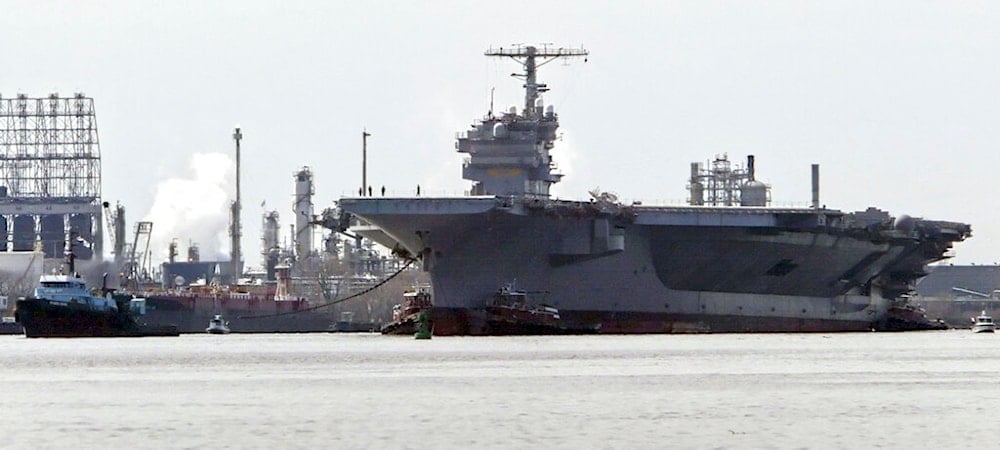‘Critical challenges’ threaten delivery of US ford-class carrier JFK
The USS John F. Kennedy (CVN 79) is facing delays due to unresolved technical issues, while the original carrier of the same name has been sold by the US Navy for scrap.
-
 In this March 22, 2008, file photo, the retired aircraft carrier USS John F. Kennedy makes its way up the Delaware River guided by tug boats near Philadelphia (AP, File)
In this March 22, 2008, file photo, the retired aircraft carrier USS John F. Kennedy makes its way up the Delaware River guided by tug boats near Philadelphia (AP, File)
The US Navy had scheduled the official delivery of the USS John F. Kennedy (CVN 79), the second aircraft carrier in the Gerald R. Ford class, for July, but that timeline is likely to be missed due to a series of unresolved and long-standing "critical challenges", the 1945 news website reported on Sunday.
Named in honor of assassinated President John F. Kennedy, CVN 79 follows the legacy of the original USS John F. Kennedy (CV 67), which served as a fleet carrier for more than five decades before its decommissioning in 2007. The earlier vessel was the last conventionally powered aircraft carrier built for the US Navy.
Major issues hinder delivery
Testimony presented before the Senate Armed Services Committee’s sea power panel revealed that major issues remain with key systems aboard CVN 79, including the weapons elevators and the electromagnetic aircraft launch and recovery systems (EMALS).
The ship is reportedly 95% complete, with builder HII still contractually obligated to deliver it this July. However, industry observers expect the timeline could slip by up to a year. The original delivery target was 2022, later postponed to 2024.
Despite these delays, both the Navy and HII have emphasized their commitment to completing the vessel, insisting they are “hyper-focused” on delivering a fully operational ship, crew, and air wing as efficiently as possible. This message was delivered in a joint statement co-authored by Rear Admiral Casey Moton, Program Executive Officer for Aircraft Carriers.
The John F. Kennedy is the second of four Ford-class carriers. The first, USS Gerald R. Ford (CVN 78), was delivered in May 2017—over two and a half years behind schedule—with nonfunctional weapons elevators and other unfinished systems. Those shortcomings were only fully addressed in the years that followed. The Ford completed its first deployment in January 2024 and played a role in the US military’s support for "Israel following the Palestinian Resistance's October 7, 2023, operation.
The Kennedy was unveiled at HII’s Newport News Shipbuilding facility in December 2019. At the time, the Navy was operating under a “dual-phase delivery plan,” in which the main construction would be completed first, followed later by final outfitting and integration of additional systems.
The plan intended to give HII more time to install updated technologies, including modifications required to operate the F-35C. However, Congress later mandated that the Kennedy must be fully capable of operating the F-35C before completing its Post-Shakedown Availability (PSA), effectively ending the dual-phase approach.
1945 indicated that this episode reflects broader challenges facing US naval aviation and shipbuilding. The Navy continues to fall behind in fielding next-generation aircraft such as the F/A-XX, while the decline in US shipbuilding capacity raises serious strategic concerns. In 2022, American shipyards produced just five oceangoing commercial ships compared to 1,794 built in China and 734 in South Korea.
The Navy estimates that China’s shipbuilding capacity is 232 times greater than that of the US, and the cost of building ships domestically is roughly double that of foreign competitors.
As highlighted in a recent USNI article, China's expanding shipbuilding industry and the rapid growth of its navy provide Beijing with a significant strategic edge in any prolonged maritime conflict.
Read more: US Navy faces crisis as only 13 of 32 amphibious ships ready for duty
From warship to scrap: USS John F. Kennedy sold for one cent
In a related context, 1945 reported that the USS John F. Kennedy (CV 67), also known as the "Big John", has been sold for scrap for a symbolic one penny and is now on its final journey to be dismantled.
After spending 17 years at the Inactive Ship Maintenance Facility in Philadelphia, the vessel is en route to the International Shipbreaking Limited facility in Brownsville, Texas. Once it arrives, the storied carrier will be dismantled.
Big John is expected to complete the voyage later this month, having traveled south along the Atlantic coast and around Florida to reach its final destination. It remains unclear when the actual dismantling process will begin. The scrapyard acquired both the John F. Kennedy and the USS Kitty Hawk for a nominal fee after multiple efforts to preserve the vessels as museum ships proved unsuccessful.
There were also attempts to sell the John F. Kennedy to India. Because the ship was conventionally powered rather than nuclear-propelled, there had been hope it could be preserved for public display—something not possible with nuclear-powered carriers.
The John F. Kennedy was the last conventionally powered aircraft carrier built for the US Navy. While it did not serve in the Vietnam War, it completed numerous deployments during the Cold War and participated in several key US military operations in the Middle East.
During the 1973 Six-Day War between Arab forces and "Israel", the Kennedy patrolled the Mediterranean and supported a major US resupply effort to bolster "Israel". In 1983, it conducted aviation operations off the coast of Lebanon during the US Marine Corps deployment to Beirut. The ship also took part in the 1990-1991 Gulf War, with its aircraft flying numerous sorties in support of US and coalition forces against Iraq.
Following the September 11 attacks, Big John was deployed off the US East Coast to guard against further threats. It was then sent to South Asia, off the coast of Pakistan, where it supported the initial invasion of Afghanistan, conducted special operations missions against al-Qaeda, and participated in airstrikes during the search for the group's leader Osama bin Laden.
Read more: US Navy wastes $1.84Bln on failed cruiser upgrades: GAO report

 6 Min Read
6 Min Read










